Lane Surname Ancestry ResultsOur indexes 1000-1999 include entries for the spelling 'lane'. In the period you have requested, we have the following 2448 records (displaying 1421 to 1430): Single Surname Subscription | | | Buying all 2,448 results of this search individually would cost £14,226.00. But you can have free access to all 2,448 records for a year, to view, to save and print, for £100. Save £14,126.00. More... |
These sample scans are from the original record. You will get scans of the full pages or articles where the surname you searched for has been found. Your web browser may prevent the sample windows from opening; in this case please change your browser settings to allow pop-up windows from this site. Boys entering Trinity College, Glenalmond
(1848)
Trinity College, Glenalmond, Perthshire, was originally founded as a college at which young men might be trained for the ministry of the Scottish Episcopal Church, and the sons of the laity might be educated and brought up in the faith and tradition of the Church. In 1876 the Theological College was transferred to Edinburgh, Glenalmond remaining as a boys' school. This second edition of the school register, edited by G. St Quintin, was published in 1955, incorporating the text of the first edition prepared by E. W. Neish. The scholars are listed by term of entering the school, and then alphabetically by surname; the details then given are full christian names, date of birth; name of father; any distinctions within the school; and then a career synopsis, with date and place of death where known. LANE. Cost: £6.00.  | Sample scan, click to enlarge
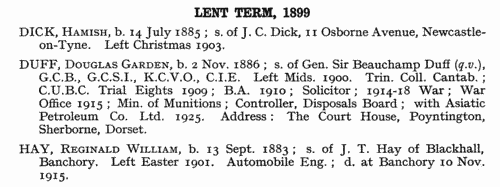
| Deaths, Marriages, News and Promotions
(1848)
Death notices and obituaries, marriage and birth notices, civil and military promotions, clerical preferments and domestic occurrences, as reported in the Gentleman's Magazine. Mostly from England and Wales, but items from Ireland, Scotland and abroad. July to December 1848.LANE. Cost: £4.00.  | Sample scan, click to enlarge

| Directory of Bath
(1848)
Hunt & Co.ís 'Directory & Court Guide for the Cities of Bath, Bristol, & Wells, and the Towns of Bradford, Calne, Chippenham, Devizes, Frome, Lavingtons, Melksham, Shepton Mallet, Trowbridge, Warminster, & Westbury, containing The Names and Addresses of The Nobility, Gentry, Clergy, Professional Gentlemen, Traders, &c. Resident therein. A Descriptive Account of each Place, Post-Office Information, Copious Lists of the Public Buildings, Law, and Public Officers - Particulars of Railroads, Coaches, Carriers, and Water Conveyances - Distance Tables, and other Useful Miscellany', published in May 1848 includes this alphabetical directory of Bath.LANE. Cost: £4.00.  | Sample scan, click to enlarge
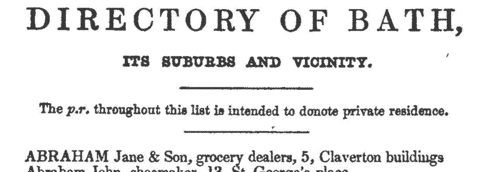
| Dissolutions of Partnerships
(1848)
Trade partnerships dissolved, or the removal of one partner from a partnership of several traders, in England and Wales
LANE. Cost: £6.00.  | Sample scan, click to enlarge

| Electors for Clifford-cum-Boston
(1848)
On 14 and 15 December 1848 an election took place for a Knight of the Shire for the West Riding of Yorkshire in the House of Commons. The candidates were Edmund Denison and sir Culling Eardley Eardley, gaining 14,743 and 11,795 votes respectively. The county franchise at this period included freeholders of land worth 40s or more a year; £10 copyholders and long-leaseholders; and £50 short-leaseholders and tenants. This poll book was published in 1849.
Former poll books had been compiled from the sheriff's returns; but as these were now transmitted to the Home Office immediately after an election, in this instance the polling was marked from the check-clerk's returns, carefully compared with the registers marked in the poll booths at the time of voting.
The votes for the respective candidates are indicated by the numerals 1 (Denison) and 2 (Eardley). The omission of these numerals indicates that the elector did not vote. Many names which appear on the register of particular townships are completely omitted in this poll book: in all these cases, the same name will be found recorded in some other township, the elector having two or more qualifications. In such cases, his name only appears in the poll book in the actual township for which he chose to vote; or, if he did not vote at all, in that township for which he was qualified that lay closest to his actual residence.
The townships are arranged alphabetically within polling district; and within each township the names are arranged alphabetically by surname and christian name, and the elector's residence is given. Many of the electors resided outside the township for which they were qualified - some in other counties. Moreover, at the end of each polling district there is a list of persons registered to poll in that district, from townships is other districts. LANE. Cost: £6.00.  | Sample scan, click to enlarge
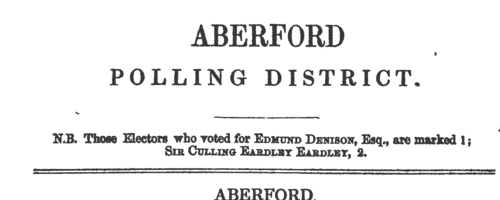
| Electors for Tickhill
(1848)
On 14 and 15 December 1848 an election took place for a Knight of the Shire for the West Riding of Yorkshire in the House of Commons. The candidates were Edmund Denison and sir Culling Eardley Eardley, gaining 14,743 and 11,795 votes respectively. The county franchise at this period included freeholders of land worth 40s or more a year; £10 copyholders and long-leaseholders; and £50 short-leaseholders and tenants. This poll book was published in 1849.
Former poll books had been compiled from the sheriff's returns; but as these were now transmitted to the Home Office immediately after an election, in this instance the polling was marked from the check-clerk's returns, carefully compared with the registers marked in the poll booths at the time of voting.
The votes for the respective candidates are indicated by the numerals 1 (Denison) and 2 (Eardley). The omission of these numerals indicates that the elector did not vote. Many names which appear on the register of particular townships are completely omitted in this poll book: in all these cases, the same name will be found recorded in some other township, the elector having two or more qualifications. In such cases, his name only appears in the poll book in the actual township for which he chose to vote; or, if he did not vote at all, in that township for which he was qualified that lay closest to his actual residence.
The townships are arranged alphabetically within polling district; and within each township the names are arranged alphabetically by surname and christian name, and the elector's residence is given. Many of the electors resided outside the township for which they were qualified - some in other counties. Moreover, at the end of each polling district there is a list of persons registered to poll in that district, from townships is other districts. LANE. Cost: £6.00.  | Sample scan, click to enlarge
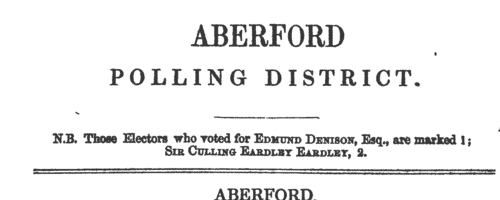
| Insolvents
(1848)
Insolvency notices for England and Wales: insolvency often caused people to restart their lives elsewhere, so these are an important source for lost linksLANE. Cost: £6.00.  | Sample scan, click to enlarge

| Merchant Seamen: Masters
(1848)
The Board of Trade 19 April 1848 issued this list of all the masters and mates in the merchant service who had voluntarily passed an examination, and obtained certificates of qualification for the class against each assigned, under their regulations. The table gives the full name, class of certificate, and usually gives age, present or last previous service (name and tonnage of ship, sometimes stating in what capacity), number of register ticket (if any), where examined and when.LANE. Cost: £4.00.  | Sample scan, click to enlarge

| Oxford Area Supporters of the Church Missionary Society: Pembroke College
(1848)
The Twenty-Third Report of the Association for Oxford and its Vicinity in Aid of the Church Missionary Society, published in 1848, lists annual subscriptions and donations and subscriptions from individual parishes and branches.LANE. Cost: £4.00.  | Sample scan, click to enlarge

| British Army officers in the annexation of the Punjab
(1845-1849)
By 1845 the Sikh state of Lahore was the remaining substantial military power in the Indian sub-continent outside British rule. Its khalsa army was well equipped, disciplined, tenacious and had three European officers among its commanders. The sikhs controlled not only the Punjab, but Pathan tribes as far as the border with Afghanistan, and the whole of Kashmir. The river Sutlej formed the boundary between the Sikh state and British India. In early December 1845 the Sikh army crossed the Sutlej and invested the British garrisons at Ferozepore; 13 December 1845 the British declared war. After defeat in a series of battles, at Moodkee (18-21 December), Ferozeshah (21-22 December); Budhowal and Aliwal (23 December, 28 January); and Sobraon (10 February 1846), the state of Lahore submitted to the Treaty of Lahore, ceding the Punjab between the Sutlej and the Beas, Kashmir, and paying half a crore of rupees. The state of Lahore itself continued under the durbar as a British protectorate during the minority of the young maharajah; and the Sikh army was put under British command. Kashmir was sold by the British to the ruler of Jammu for a crore, and the submission of Kashmir to Jammu was effected by a Sikh force under British officers. British garrisons were placed in the Punjab, but the fort at Multan refused to submit, and had to be besieged. During the siege a Sikh regiment defected to join other khalsa remnants, in defiance of the durbar at Lahore, and raised a rebellion (August 1848 to January 1849). Battles at Chillianwalla (13 January 1849) and Gujerat (21 February 1849) destroyed the Sikh army. The British then annexed the whole of the Punjab, incorporating it into British India. This account of the Annexation of Punjab by Arthur D. Innes and General Charles Gough was published in 1897, but with a poor index; we have remedied that. The account also includes a description of the battles of Maharajapore and Puniar (29 December 1843) by which the army of Gwalior was destroyed. LANE. Cost: £6.00.  | Sample scan, click to enlarge
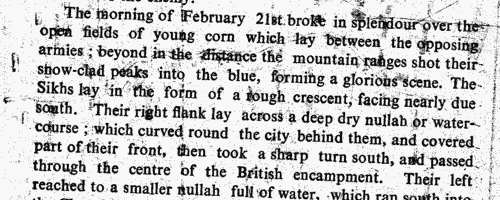
|
Research your ancestry, family history, genealogy and one-name study by direct access to original records and archives indexed by surname.
|












